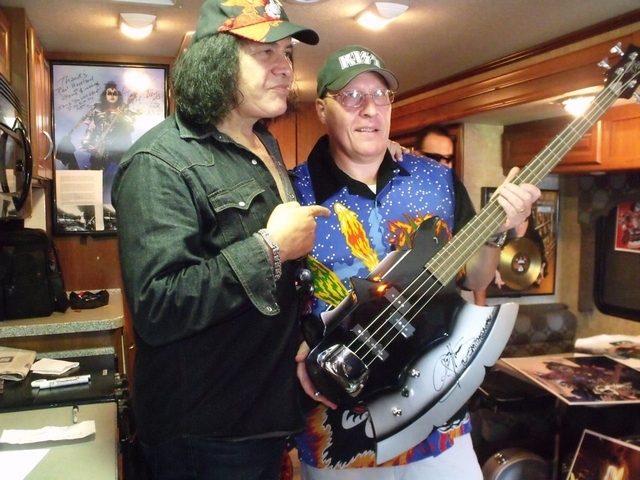Glen Smith | The Post and Courier
 John Downs wasn’t the fastest runner in Thursday’s annual Turkey Trot road race in Charleston. But to be fair, it’s not easy to make good time in a pair of metal-scaled demon boots with 6-inch platform heels.
John Downs wasn’t the fastest runner in Thursday’s annual Turkey Trot road race in Charleston. But to be fair, it’s not easy to make good time in a pair of metal-scaled demon boots with 6-inch platform heels.
It’s become a tradition for Downs to run the race each year slathered in makeup and sporting the spiked armor of his favorite musician, Gene Simmons, bassist for the rock band Kiss. His brother gets in on the act as well, taking on the starry-eyed persona of guitarist Paul Stanley.
These are middle-aged men, mind you. John Downs runs a successful auto glass company in Charleston. His brother, Jamie, is a regional medical examiner for the Georgia Bureau of Investigation.
They’re both in the early 50s. But just mention Kiss, and they suddenly revert to the same fist-pumping teens who borrowed dad’s car to cheer on the flamboyant band from a pair of nosebleed seats in Columbia in 1977
It was the brothers’ first concert, and they’ve been loyal members of the Kiss Army ever since, attending the group’s shows, fan conventions and cruises whenever they get a chance. There’s just something about that hard rock sound, the flash pots, fire-breathing and blood-spitting. They were hooked from the start.
“Everyone has hobbies,” John Downs said. “Mine just happens to be Kiss.”
Like a lot of Kiss fans, the Downs brothers bristle at the Rock and Roll Hall of Fame’s failure to induct the costume-clad band into its ranks — an unforgivable snub to some. But this year, John Downs happened on an idea to get his hero some recognition from an even more distinguished forum — the Smithsonian Institution, the world’s largest museum.
John Downs read a magazine article that mentioned how one of guitarist Eddie Van Halen’s signature axes had been donated to the Smithsonian to be preserved for posterity. Why, he wondered, couldn’t one of Simmons’ iconic basses receive the same recognition?
Downs, who has seen the band about 20 times, got to know Simmons through various fan events and has purchased 15 of his idol’s instruments to display in a Kiss shrine Downs keeps in his James Island home. Though these instruments sell for up to $15,000 a pop, Downs was willing to let one go for the cause. He chose one worth about $2,500 for the occasion.
So Downs worked the phones until he reached Eric W. Jentsch, deputy curator for the Smithsonian’s National Museum of American History. The museum’s expansive collection includes everything from original sheet music penned by jazz great Duke Ellington to Stradivari violins and a cigar box guitar from the mid-1800s. Oh, and a Kiss lunch box and Thermos from the 1970s.
While the axe-shaped bass Downs proffered had not actually been played by Simmons on stage, it had his autograph and other intrinsic value that “works on a number of different levels,” Jentsch said. It illustrates Simmons’ knack for merchandising and the strong fan connection enjoyed by a man who immigrated to America from Israel, learned English through comic books and created a lasting musical and commercial legacy, he said.
“We don’t just want to collect the highest-end guitar. We want to show the American experience with the guitar,” Jentsch said. “We like to tell broad stories, and Gene Simmons is a story unto himself.”
The Downs brothers wholeheartedly agree. Jamie Downs has long been inspired by Simmons’ rags-to-demon-destroyer story and the work ethic displayed by an improbable band that beat the odds to achieve fame and riches. It so impressed him, in fact, that he dedicated a forensic science textbook he edited to Simmons and Stanley.
“I learned from them the power of hard work, following your dreams and not taking ‘No’ for an answer,” he said.
After getting Simmons to sign a dedication note to the Smithsonian on the bass, John Downs sent it off to Washington. He received a letter in return, lauding Simmons’ use of “creative vision and entrepreneurial acumen to make a significant impact for our nation’s popular culture, becoming an iconic figure in American music and entertainment.”
The Downs brothers handed a framed plaque with the letter to Simmons during a surprise presentation aboard Kiss Kruise III, a seagoing fan-fest through the Caribbean around Halloween. It took on special meaning for John Downs because he turned 54 that day.
With his brother by his side and wearing a multi-colored shirt modeled on the group’s “Rock and Roll Over” album, John Downs read the Smithsonian letter to Simmons and a crowd of 1,500.
“That means a lot more than the hall of fame any day!” someone shouted from the audience.
Jamie Downs grabbed the microphone and thanked Simmons for “all you mean to this country, for what you’ve done and been through. You’ve taught me so much in my life, and we’re just proud to be your fans.”
For his part, Simmons was uncharacteristically at a loss for words, though he called John Downs “an extra-special guy” and applauded the brothers’ efforts. “It was very sweet of you,” he said. “I’m humbled, and I don’t know what to say.”
For John Downs, the moment was surreal and exhilarating, making him think for a moment about that first concert at Carolina Coliseum, sitting with his back pressed to the wall in the cheap seats.
“To go from the very back row all the way to on-stage presenting this to him,” he said, “it’s kind of like every kid’s dream come true.”
